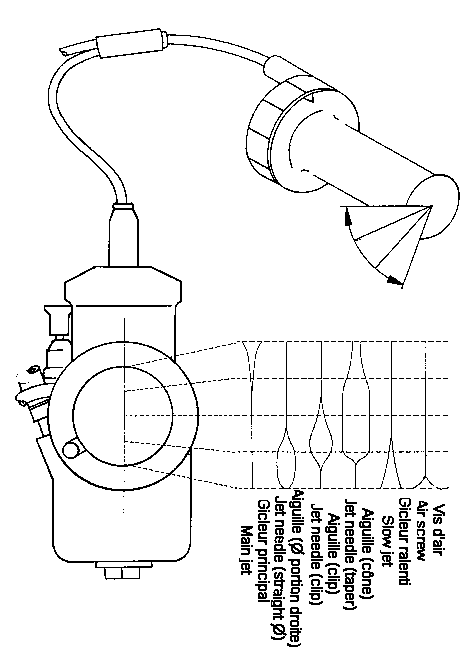
Back to home page
Back to motorcycling main
page

The influence of the various carburetor components. You can easily see that at full throttle, as in racing usage, the main jet is predominent.
Some data furnished by Honda:
| Parameter | Standard Conditions |
Conditions Change |
Main Jet Change |
| Temperature | 20°C | + 4-5°C | - 1 rank |
| Humidity | 60% | + 20% | - 1 rank |
| Pressure | 760 mmHg 1013 mB |
+ 25 mmHg + 30-35 mB |
+ 1 rank |
When you do a carb stop (engine stop and clutch pulled at the quickest part of the track), the colors of the plug and the head of the piston give good indications about the carburation. According to the conditions (engine tune-up, humidity, oil, ...) here is what you can obtain:
| Plug color | 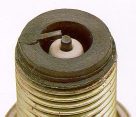 |
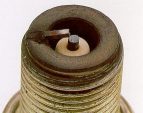 |
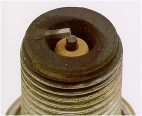 |
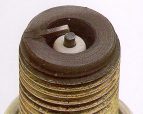 |
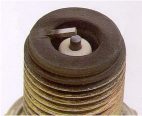 |
| Running distance | 30km or less | 30-60km | 30-60km | 60-90km | 60-90km |
| Isolator color | no color | very light brown or golden brown |
golden brown | white | white |
| Burn dimensions on the ground electrode |
1.5mm or less | 1.5mm or less |
1.5mm or less |
1.5mm or more |
|
| Comments | distance to short to judge |
If the isolator is sligthly colored the heat rating of the plug is ok If even after more
than 60km |
good | overburned plug heat rating is to low |
overburned carburation to lean |
This is an approximated method I developed during my first
season in 89'.
Purist certainly will find some rough approximations but, in the
practice, it does work and helps you save a lot of time during
the first training sessions.
Theory lets you approximate the right choice of the main jet
in a 2-stroke engine.
23% (in weight) of the air is composed by oxygen, so 1gr of
gasoline needs 15gr of air to be completely burnt.
This proportion varies in fact between 17 on everyday riding to
13 in competition.
A high level of humidity imposes to lean a few the mix.
The volumic mass of the air can be evaluated by:
1,2932
p
Da = ----------------- . -----
1 + 0,00367 t
1013
Da = volumic mass of the air in g/dm3
p = pressure in millibars
t = temperature in °C
Download a spreadsheet for the air
density (Excel 7.0 32bits)
Download a spreadsheet for the air
density (Excel 4.0 16bits)
The quantity of gasoline can be evaluated by:
Cy
Tr Rm Ne
Qe = Da ----------------
Re
De Te
Qe = gasoline quantity in g/mn
Da = volumic mass of the air in g/dm3
Re = air/gasoline ratio (15, 10-18)
Cy = cylinder volume in dm3
Tr = fillment ratio (100% = 1)
Rm = rpm max of the engine
De = gasoline density
Ne = explosions/round: 0,5 for 4-stroke and 1 for 2-stroke
Te = gasoline throughput ratio (100% = 1)
which could be simplified for a racing 2-stroke engine:
Re = 13
Cy = 0,125
Tr = 0,89 (greater with direct air intake)
Rm = 12000
De = 0,734
Ne = 1
Te = 1
and we obtain a very simple formula:
Qe = Da Cc
Cc = carb. coefficient
Qe = main jet dimension
This carburetor coefficient (Cc) varies from one bike to another,
from one engine preparation to another and also from one track to
another. But for a given bike and track, it remains constant.
This lets you calculate the main jet also when the conditions
change during the week-end or between the early morning and
mid-afternoon or if you're back to a track six months later ...
So, all you need to do, is:
1. make a good carburation
2. measure the air pressure, temperature and humidity ratio
3. calculate the air density
4. calculate the coefficient for this track
With a few experience, you'll evaluate the coefficient of an unknown track rapidly and have a great advantage over the other pilots.
Changes in the engine preparation means a change also in the
coefficient but this change in the coeff. is usually proportional
from one track to the other, so you can evaluate it quite easily.
The better your preparation is, the greater the coefficient will
be: that means more air and gasoline in the engine per explosion.
That could be a good indicator of the validity of your changes.
Bikes with dynamic air intakes are very sensitive to the speed
as a greater speed puts more air in the cylinder through the
air-box. On these bikes, the coefficient will vary greatly from a
slow track to a quick one.
The exhaust gas temperature is a good indicator of the carburation. The leaner the carburation, the higher the temperature and vice-versa.
The temperature varies greatly from one point of the exhaust
expansion to another:
The first part of an expansion is an open cone, that means the
pressure decreases and so does the temperature (it's not because
the gas is cooling but mainly because of the "angle" of
this cone).
For example, with the 125 Sport Production Aprilia, the high-speed thermometer was placed around 10cm from the exhaust port (the display was mounted close to the RPM indicator) and the temperature reached 750-800°C.
On the Honda RS125R (GP), there were too many vibrations at that point and I should put it right after the silencer, but of course it wasn't the best place at all !
So, all you need to do, is:
1. make a good carburation
2. read the maximum temperature on the display at the quickest
place of the track
3. during the other sessions, check that this temperature do not
vary to much
I mounted this thermometer (there are good ones at Greisinger in Germany) through a small hole in a screw, the corresponding nut was soldered on the exhaust. In such a way, the thermometer was always at the right and same place and can be dismounted easily.
A change in the air temperature makes the exhaust gas temperature vary too: if you have 750°C during a test at 10°C, at 40°C you'll probably have something closer to 780°C.
The humidity ratio makes the exhaust gas temperature vary too, for example with the Aprilia:
Humidity ratio ¦ gas
temperature
------------------------------------------
Ratio <
45% ¦ 790
45% < Ratio <
50% ¦ 780
50% < Ratio <
55% ¦ 775
55% < Ratio <
60% ¦ 770
60% < Ratio <
70% ¦ 760
Ratio >
70% ¦ 750
Here is a small empirical formula:
diff.temp. x 100
----------------- = diff. jet
temp.test x 1,23
Telemetry is of course the best method as it could measure the temperatures over all parts of the track and the full range of the RPM of the engine but the prices of telemetry have nothing to see with such simple but effective solutions.